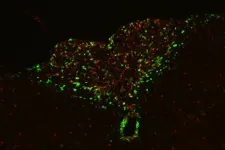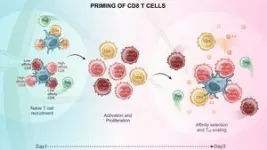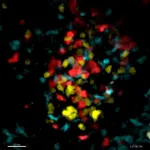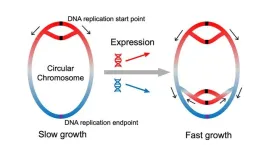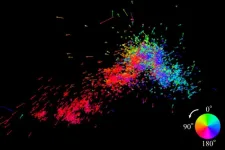(Press-News.org) The fatigue and lack of motivation that many cancer patients experience near the end of life have been seen as the unavoidable consequences of their declining physical health and extreme weight loss. But new research from Washington University School of Medicine in St. Louis challenges that long-held assumption, showing instead that these behavioral changes stem from specific inflammation-sensing neurons in the brain.
In a study published April 11 in Science, the researchers report that they identified a direct connection between cancer-related inflammation and the loss of motivation characteristic of advanced cancer. Studying mice with cancer-linked cachexia, a condition typical of the disease that leads to muscle wasting and weight loss, they discovered a previously unrecognized pathway in the brain. This pathway senses inflammation and actively suppresses dopamine — a key driver of motivation — resulting in apathy and loss of drive.
Blocking the pathway restored motivation, even though the cancer and weight loss continued. This indicates that apathy can be treated separately from the disease itself.
“The implications of the research are profound,” said the study’s lead author, Adam Kepecs, PhD, professor of neuroscience and of psychiatry at WashU Medicine. “We’ve uncovered a direct brain mechanism through which inflammation drives apathy in cancer, and we were able to restore normal motivation in mice with cachexia, despite ongoing inflammation as cancer progressed.”
About 70% of patients with advanced cancer experience cachexia. In addition to physical decline, patients often suffer from severe fatigue, apathy and a lack of motivation that affect their overall quality of life.
To understand whether these psychological symptoms are side effects that emerge from physical deterioration or whether they arise from distinct biological mechanisms, the research team, including Marco Pignatelli, MD, an assistant professor of psychiatry at WashU Medicine, and Tobias Janowitz, MD, PhD, an associate professor at Cold Spring Harbor Laboratory, turned to a well-validated mouse model of cancer cachexia. They focused specifically on behavioral symptoms, which had not previously been investigated, and mapped the brain regions involved.
They discovered that a structure in the brainstem, a part of the brain that controls vital functions such as breathing and heart rate, acts as a sensor for inflammatory signals in the bloodstream, particularly a molecule called interleukin-6 (IL-6), which is elevated in cancer cachexia. When IL-6 levels rise, neurons in this region of the brainstem transmit a signal through a defined pathway that suppresses dopamine release in a part of the brain called the nucleus accumbens, which is key for motivation and reward. The resulting drop in dopamine had the effect of making the mice less motivated to exert themselves to complete activities.
To see if interfering with this response could treat the lack of motivation and apathy, Kepecs and his colleagues tried two different approaches: they boosted dopamine levels and blocked inflammation-sensing neurons in the brainstem. Both approaches eliminated or reduced apathy in the mice. Treating the mice with an IL-6 antibody similar to an existing FDA-approved drug for rheumatoid arthritis, an inflammatory condition, also restored the animal’s motivation, a finding that points to a potential treatment for the psychological symptoms associated with advanced cancer.
“What’s remarkable is that motivation was restored even in late-stage disease,” said Pignatelli. “It suggests we may be able to improve quality of life by targeting the brain circuit.”
For acute illnesses such as infections, this inflammation-driven reduction in motivation may be adaptive, helping the body conserve energy to fight off disease, Kepecs explained. But in chronic conditions such as cachexia, prolonged apathy — including a reduced drive to eat, move or engage socially – can become harmful, worsening health and quality of life. Because IL-6 — the inflammatory molecule driving this effect — is elevated in many other conditions, and the brain regions involved are central to motivation, this same circuit likely contributes to apathy across a range of chronic illnesses.
“This gives us a new way to understand apathy in advanced cancer,” said Kepecs. “It’s not just a byproduct of physical decline, but a direct response to inflammation in the brain. That means we can potentially target the underlying biology to improve motivation and quality of life — even when the cancer itself is no longer treatable.”
Zhu XA, Starosta S, Ferrer M, Hou J, Chevy Q, Lucantonio F, Muñoz-Castañeda R, Zhang F, Zang K, Zhao X, Fiocchi FR, Bergstrom M, Siebels AA, Upin T, Wulf M, Evans S, Kravitz AV, Osten P, Janowitz T, Pignatelli M, Kepecs A. A neuroimmune circuit mediates cancer cachexia-associated apathy. Science. April 11, 2025. DOI: 10.1126/science.adm8857
This research was funded by the National Institute of Child Health and Human Development of the National Institutes of Health (NIH) grant P50 HD103525, Deutsche Forschungsgemeinschaft grant DFG -STA 1544, LaCaixa, the Mark Foundation for Cancer Research grant 20-028-EDV, the Simons Foundation, Cancer Grand Challenges, NIH grant 1OT2CA278690-01, CRUK: CGCATF-2021/ 100019, and NIH/National Cancer Institute grant R37CA286477-01A1, Cancer Center Support grant 5P30CA045508, NIMH grant MH130610, the Taylor Family Institute for Innovative Psychiatric Research, the Hope Center Pilot Grant, the McDonnell Center for Systems Neuroscience Small Grant, and the NARSAD Young Investigator Grant 27102 and P&S Fund, a WUSTL BJC investigator award and NIH grant DP1 MH14002. The content is solely the responsibility of the authors and does not necessarily represent the official views of the NIH.
About Washington University School of Medicine
WashU Medicine is a global leader in academic medicine, including biomedical research, patient care and educational programs with 2,900 faculty. Its National Institutes of Health (NIH) research funding portfolio is the second largest among U.S. medical schools and has grown 56% in the last seven years. Together with institutional investment, WashU Medicine commits well over $1 billion annually to basic and clinical research innovation and training. Its faculty practice is consistently within the top five in the country, with more than 1,900 faculty physicians practicing at 130 locations and who are also the medical staffs of Barnes-Jewish and St. Louis Children’s hospitals of BJC HealthCare. WashU Medicine has a storied history in MD/PhD training, recently dedicated $100 million to scholarships and curriculum renewal for its medical students, and is home to top-notch training programs in every medical subspecialty as well as physical therapy, occupational therapy, and audiology and communications sciences.
END
Brain pathway links inflammation to loss of motivation, energy in advanced cancer
Study in mice shows motivation can be restored with targeted treatments
2025-04-10
ELSE PRESS RELEASES FROM THIS DATE:
Researchers discover large dormant virus can be reactivated in model green alga
2025-04-10
Researchers had been studying the green alga Chlamydomonas reinhardtii for decades without seeing evidence of an active virus within it — until a pair of Virginia Tech researchers waded into the conversation.
Maria Paula Erazo-Garcia and Frank Aylward not only found a virus in the alga but discovered the largest one ever recorded with a latent infection cycle, meaning it goes dormant in the host before being reactivated to cause disease.
“We’ve known about latent infections for a long time,” said Aylward, associate professor in the Department of Biological Sciences. ...
New phase of the immune response uncovered
2025-04-10
The research groups led by Wolfgang Kastenmüller and Georg Gasteiger employed innovative microscopy techniques to observe how specific immune cells, known as T-cells, are activated and proliferate during a viral infection. Their findings revealed novel mechanisms: the immune system amplifies its defense cells in a far more targeted way than previously believed.
T-Cells Proliferate and Specialize During the Immune Response
T-cells are crucial defense cells in the immune system. To effectively ...
Drawing board rather than salt shaker
2025-04-10
Bioinformaticians from Heinrich Heine University Düsseldorf (HHU) and the university in Linköping (Sweden) have established that the genes in bacterial genomes are arranged in a meaningful order. In the renowned scientific journal Science, they describe that the genes are arranged by function: If they become increasingly important at faster growth, they are located near the origin of DNA replication. Accordingly, their position influences how their activity changes with the growth rate.
Are genes distributed randomly along the bacterial chromosome, as if scattered from a salt shaker? This opinion, which is held by a majority of researchers, has ...
Engineering invites submissions on AI for engineering
2025-04-10
Artificial intelligence (AI) is playing an increasingly pivotal role in revolutionizing the field of engineering, triggering a new era of technological and industrial evolution. A series of recent breakthroughs in areas like natural language processing, computer vision, and machine learning, with the Nobel Prize-winning work in artificial neural networks and protein structure prediction serving as prime examples, have effectively bridged the gap between the physical and digital worlds. The emergence of general AI technologies, especially large language models, has given rise ...
In Croatia’s freshwater lakes, selfish bacteria hoard nutrients
2025-04-10
Bacteria play key roles in degrading organic matter, both in the soil and in aquatic ecosystems. While most bacteria digest large molecules externally, allowing other community members to share and scavenge, some bacteria selfishly take up entire molecules before digesting them internally. In a paper publishing April 10 in the Cell Press journal Cell Reports, researchers document “selfish polysaccharide uptake” in freshwater ecosystems for the first time. In Croatia’s Kozjak and Crniševo Lakes, they found that nutrient hoarding allows selfish species ...
Research suggests our closest neighboring galaxy may be being torn apart
2025-04-10
A team led by Satoya Nakano and Kengo Tachihara at Nagoya University in Japan has revealed new insights into the motion of massive stars in the Small Magellanic Cloud (SMC), a small galaxy neighboring the Milky Way. Their findings suggest that the gravitational pull of the Large Magellanic Cloud (LMC), the SMC’s larger companion, may be tearing the smaller one apart. This discovery reveals a new pattern in the motion of these stars that could transform our understanding of galaxy evolution and interactions. The results were published ...
Researchers identify factors in early-life linked to body fat in South Asian children
2025-04-10
Researchers at McMaster University have identified six key factors in the first three years of life that influence the trajectory of obesity in South Asian children.
The findings offer parents, primary care practitioners and policymakers new insights into addressing childhood obesity for a group of children who have a higher prevalence of abdominal fat and cardiometabolic risk factors, as well as a predisposition to diabetes.
“We know that current measures of childhood obesity such as the body mass index (BMI) don’t work well for South Asians because of the so called ‘thin-fat’ phenotype: South Asian newborns are characterized as low birth weight, but proportionally ...
Environment: Less than 10% of global plastics manufactured from recycled materials
2025-04-10
Only 9.5% of plastic materials produced globally in 2022 were manufactured from recycled materials. The findings, reported in Communications Earth & Environment, are part of a comprehensive analysis of the global plastics sector, which also reveals a large increase in the amount of plastic being disposed of by incineration and substantial regional differences in plastic consumption.
Plastic production has increased from two million tonnes per year in 1950 to 400 million tonnes per year in 2022 and ...
Influenza vaccination among people with Medicare by race and ethnicity, education, and rurality
2025-04-10
About The Study: In this cross-sectional survey study, although overall influenza vaccination rates changed little from 2019 to 2022, they increased substantially for Black and Hispanic older adults, particularly those in rural areas, and decreased for some groups of white older adults. Determining the reasons for these divergent changes in influenza vaccination rates is a high priority for future research.
Corresponding Author: To contact the corresponding author, Marc N. Elliott, PhD, email elliott@rand.org.
To access the embargoed study: Visit our For The Media website at this link https://media.jamanetwork.com/
(doi:10.1001/jamanetworkopen.2025.4462)
Editor’s ...
Neighborhood characteristics and mental health from childhood to adolescence
2025-04-10
About The Study: In this cohort study of children and adolescents, associations between neighborhood characteristics and mental health evolved from childhood through adolescence. These findings suggest that targeted interventions in disadvantaged neighborhoods and strategies to protect young children from air pollution are essential. A comprehensive approach is recommended to incorporate air pollution, green space, and socioeconomic status not only in residential neighborhoods but also in other settings, such as schools.
Corresponding Author: To contact the ...
LAST 30 PRESS RELEASES:
Making lighter work of calculating fluid and heat flow
Normalizing blood sugar can halve heart attack risk
Lowering blood sugar cuts heart attack risk in people with prediabetes
Study links genetic variants to risk of blinding eye disease in premature infants
Non-opioid ‘pain sponge’ therapy halts cartilage degeneration and relieves chronic pain
AI can pick up cultural values by mimicking how kids learn
China’s ecological redlines offer fast track to 30 x 30 global conservation goal
Invisible indoor threats: emerging household contaminants and their growing risks to human health
Adding antibody treatment to chemo boosts outcomes for children with rare cancer
Germline pathogenic variants among women without a history of breast cancer
Tanning beds triple melanoma risk, potentially causing broad DNA damage
Unique bond identified as key to viral infection speed
Indoor tanning makes youthful skin much older on a genetic level
Mouse model sheds new light on the causes and potential solutions to human GI problems linked to muscular dystrophy
The Journal of Nuclear Medicine ahead-of-print tip sheet: December 12, 2025
Smarter tools for peering into the microscopic world
Applications open for funding to conduct research in the Kinsey Institute archives
Global measure underestimates the severity of food insecurity
Child survivors of critical illness are missing out on timely follow up care
Risk-based vs annual breast cancer screening / the WISDOM randomized clinical trial
University of Toronto launches Electric Vehicle Innovation Ontario to accelerate advanced EV technologies and build Canada’s innovation advantage
Early relapse predicts poor outcomes in aggressive blood cancer
American College of Lifestyle Medicine applauds two CMS models aligned with lifestyle medicine practice and reimbursement
Clinical trial finds cannabis use not a barrier to quitting nicotine vaping
Supplemental nutrition assistance program policies and food insecurity
Switching immune cells to “night mode” could limit damage after a heart attack, study suggests
URI-based Global RIghts Project report spotlights continued troubling trends in worldwide inhumane treatment
Neutrophils are less aggressive at night, explaining why nighttime heart attacks cause less damage than daytime events
Menopausal hormone therapy may not pose breast cancer risk for women with BRCA mutations
Mobile health tool may improve quality of life for adolescent and young adult breast cancer survivors
[Press-News.org] Brain pathway links inflammation to loss of motivation, energy in advanced cancerStudy in mice shows motivation can be restored with targeted treatments
